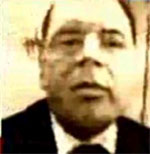|
 New Delhi: Lashkar-e-Toiba (LeT) operative Daood Sayed Gilani, a.k.a David Coleman Headley, may have confirmed to his Indian interrogators that the 26/11 Mumbai attack was stage-managed by Pakistan Army intelligence service, the ISI, at "each and every stage of the plot". His confession would go a long way towards dispelling the Pakistani myth that the 26/11 Mumbai attack was carried out by 'non-state' actors. New Delhi: Lashkar-e-Toiba (LeT) operative Daood Sayed Gilani, a.k.a David Coleman Headley, may have confirmed to his Indian interrogators that the 26/11 Mumbai attack was stage-managed by Pakistan Army intelligence service, the ISI, at "each and every stage of the plot". His confession would go a long way towards dispelling the Pakistani myth that the 26/11 Mumbai attack was carried out by 'non-state' actors.
Headley is currently under interrogation in the US by a team of National Investigation Agency officials from India. According to reports now in circulation in the Indian media, and attributed to government sources, Headley's confession would not only bring the focus back on Pakistani state actors in the global game of terrorism, but also highlight the LeT-ISI relationship and also help explain Islamabad's unwillingness to bring the Lashkar leadership and the organisation to book. Reports suggest that Headley has fingered serving officers of Pakistan army - Major Sameer Ali, Major Iqbal and Major Haroon - as those in close connect with the Laskhar terrorists. Incidentally, the names of Major Sameer and Major Iqbal also figured in the dossiers that India has provided to Pakistan. It is now being given to understand that Home minister P Chidambaram may ask for voice samples of seven Lashkar commanders including Zaki-ur-Rahman Lakhvi, Zarar Shah, Abu Al Qama and others when he meets his Pakistani counterpart Rehman Malik in the course of his visit to Islamabad to participate in the SAARC home ministers conference. Pakistan has steadfastly refused to provide voice samples of those in its custody, and those moving about free, as these would go a long way in establishing the identity of those who instructed the 26/11 LeT attackers as they went about on their killing spree. In another interesting development, Headley has apparently spilled the beans about the ISI game plan to get the LeT to disown the Mumbai attacks in a bid to deflect global attention away from the terror outfit and its obvious links to the army apparatus in Pakistan. A calculating ISI intended to blame the carnage on al-Qaeda and even prepared list of a few al-Qaeda operatives who were to be put forward as the conspirators. It was desperate to do some damage control as a LeT operative Ajmal Kasab was nabbed in the course of the mission and electronic intercepts was bringing Indian and American investigations ever closer to the LeT-ISI nexus. The plan backfired as the LeT appeared to be determined to milk the 'success' of the mission for funds and recruitment. The group was pleased with the fact that the mission had helped raise its profile as a jihadi/terrorist group. The man particularly adamant on this score was Zaki-ur-Rahman Lakhvi, the LeT's military chief. Reports suggest that Headley has also admitted that though he started off as a LeT recruit, he graduated towards the al-Qaida after coming under the influence of Major Abdul Rahman Saeed. Saeed, an ex- Baloch Regiment officer of the Pakistan Army, sought voluntary retirement in 2002 to devote himself fulltime to al-Qaida's cause. Headley, apparently rated high in the retired major's esteem because of the precise inputs he provided for the 26/11 attack garnered in the course of his scouting mission. Major Saeed, apparently also bought him into contact with top al-Qaeda operative, Ilyas Kashmiri, who drafted a plan to attack Danish newspaper Jylland Posten which published controversial cartoons of Prophet Mohammad. Headley's original handler, Sajid Mir, was keen that he remained focussed on the Lashkar's anti-India mission.
|